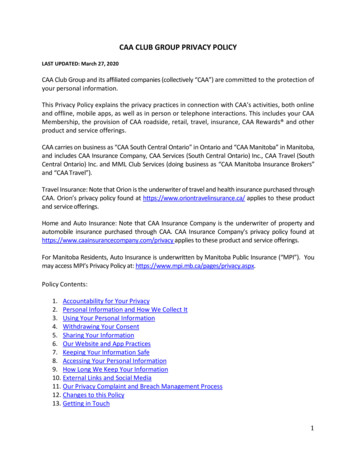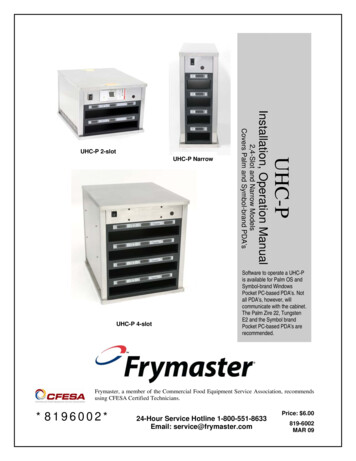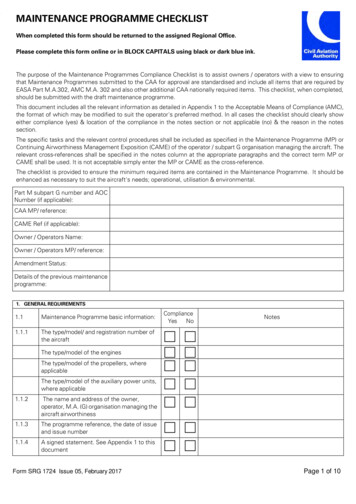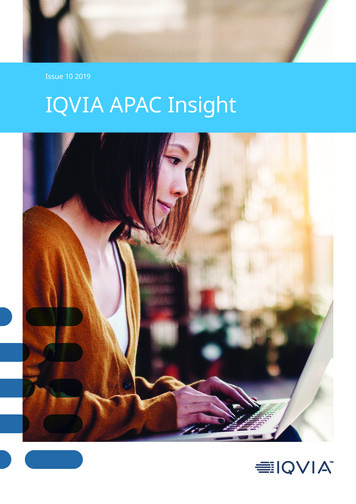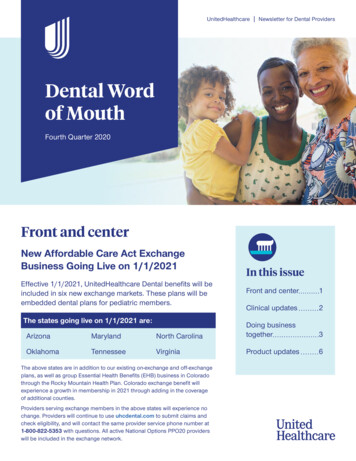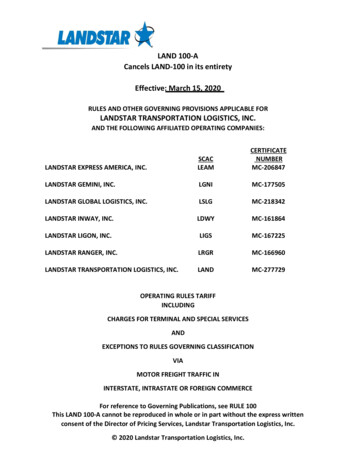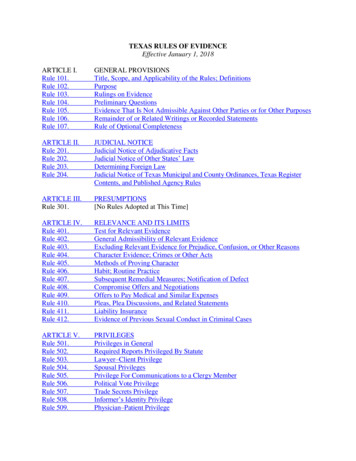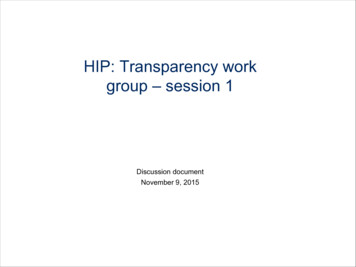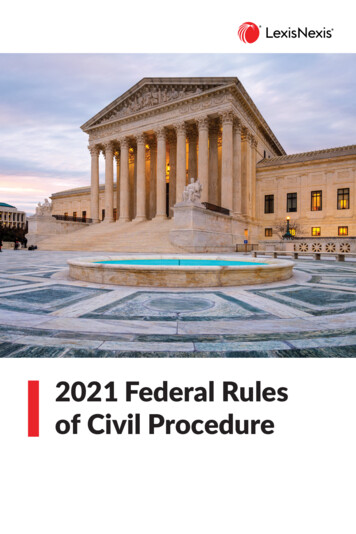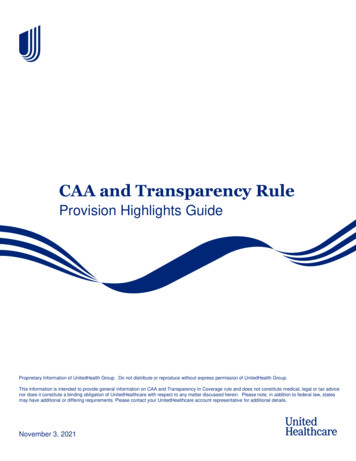
Transcription
CAA and Transparency RuleProvision Highlights GuideProprietary Information of UnitedHealth Group. Do not distribute or reproduce without express permission of UnitedHealth Group.This information is intended to provide general information on CAA and Transparency In Coverage rule and does not constitute medical, legal or tax advicenor does it constitute a binding obligation of UnitedHealthcare with respect to any matter discussed herein. Please note, in addition to federal law, statesmay have additional or differing requirements. Please contact your UnitedHealthcare account representative for additional details. 2021 UnitedHealthCare Services, Inc. All Rights Reserved.November3, 2021
Consolidated Appropriations Actincluding the No Surprises Act HighlightsNo Surprises Billing and Independent Dispute Resolution The Consolidated Appropriations Act (CAA) is a comprehensive set of regulations that included NoSurprises Act (NSA) and CAA transparency provisions. The section on surprise billing legislationprovided changes to one of the biggest issues consumers have – surprise medical bills from out-ofnetwork (OON) providers. The surprise billing legislation establishes federal standards to protect patients from balance billing fordefined items and services provided by specified doctors, hospitals and air ambulance carriers on anOON basis. The federal law applies to individual, small group, level funded and large group fully insuredmarkets and self-insured (ASO) group plans, including grandfathered plans. The legislation sets patient cost-sharing at in-network levels and requires providers to work with insurersand self-funded health plans to negotiate remaining bills. When insurers/health plans and providers areunable to reach an agreement, an Independent Dispute Resolution (IDR) process, sometimes calledarbitration, is established to determine the final reimbursement amount. The IDR entity will choose either the insurer/health plan or provider offered amount, commonly referred toas baseball arbitration. In making this decision, the IDR entity must consider the Qualifying PaymentAmount (QPA), which is the par median rate under federal regulations, and may consider other factorssuch as the provider’s market share, the provider’s training and experience, and the severity of thepatient’s condition. The law does not apply if the member chooses to receive services from an OON provider. Beginning with plan and policy years on and after January 1, 2022, the No Surprises Act applies to threetypes of services provided by health care providers and facilities:1. OON emergency covered items and services2. Certain covered medical items and services performed by an OON provider at an in-network facility3. OON air ambulance items and servicesOn September 10, 2021, a proposed rule outlined reporting requirements for health plans for air ambulanceclaims. Reporting will be required by March 31, 2023 (for 2022) and March 30, 2024 (for 2023).On July 13, 2021 and October 7, 2021, Interim Final Rules were released that provided additional detail onthe NSA requirements including prohibitions on balance billing and the IDR process. Batching of claims forarbitration of same or similar items or services are allowed. Health plans may submit separate QPAs for eachtype of item or service when similar items and services are batched. The IFR, allows the arbitrator to choosedifferent payment awards for each type.Providers and balance billingThe NSA is intended to limit what members will pay for OON services and protect them from balance billing.UnitedHealthcare will work with health plans interested in modifying their benefit plans since employees willno longer be impacted by balance bills for the situations covered under the No Surprises Act.Under the new regulations, a provider may, in advance, secure the patient’s consent to be balance billed.However, the provider would need to disclose information regarding the fact that they are out-of-networkand the member would have to agree in writing. This variation to the rule would not apply in an emergencysituation or for certain ancillary providers outlined in the provision. 2021 United HealthCare Services, Inc. All Rights Reserved.2
Independent Dispute Resolution (IDR)The NSA establishes an independent dispute resolution (IDR) process when the payer and provider disagree aboutpayment for OON services covered e.g., OON emergency services, OON items and services at a network facility andOON air ambulance services. The process* includes: After a claim/payment denial, there is a 30-day open negotiation period for insurers, health plans or providers toresolve disputes over reimbursement for OON covered items/services. If an agreement cannot be reached during the negotiation period, either the insurer/health plan or the provider mayinitiate the IDR process during the 4-day period after negotiations end. The insurer/health plan and provider may jointly agree on a certified IDR entity. If they cannot agree within 3 daysfollowing initiation of the IDR process, the Tri-Agencies will select the certified IDR entity. Within 10 days of the certified IDR entity’s selection, the insurer/health plan and provider will each submit an offerto the certified IDR entity for consideration. The certified IDR entity has 30 days from the date of selection to make a decision and to notify both theinsurer/health plan and provider of the decision. An administration fee of 50 from both parties is required when the decision is made to go to IDR. A separate IDRentity fee is paid by each party when the final offer is submitted to the IDR entity. The party whose offer is chosenby the IDR entity will have their arbiter fee returned. Additional payments are due within 30 days after final decision. UnitedHealthcare is committed to providing value added services to our self-funded customers, including theservices that relate to the new legal requirements imposed on health plans by the Consolidated Appropriations andthe No Surprises Acts. UnitedHealthcare will provide end-to-end process for negotiating surprise medical bills withproviders and administering the IDR process for health plans consistent with the No Surprises Act (NSA). Theseservices include:‒ Intake of dispute and determination if dispute is eligible for IDR based on applicable law.‒ Engage provider in formal negotiation process. Monitor and administer the negotiation process in accordancewith required timelines.‒ If negotiations fail and provider invokes formal arbitration in required time frame, then UnitedHealthcare:o Prepares and submits IDR the final offer and any additional information to the IDR entity.o Engages as needed to defend QPA/par median methodology and ‘go out rate’.o Monitors and administers required timelines and compliance with IDR rules/guidelines.o If provider offer is accepted by IDR entity, handles payment of arbitration fee, and claim paymentadjustment through customer’s claim funding account.Disclosure requirements for members Insurers and self-funded plans must publicly post notices related to surprise billing for OON items/services andinclude such notices on websites and member Explanation of Benefit (EOB) documents. UnitedHealthcare isprepared to provide disclosures as required under the No Surprises Act and will post a notice on uhc.com.Customers may link to the posted notice if they wish. The Department of Labor (DOL) provided a model notice. The notice must include the following:o The balance billing prohibitions and requirements under the No Surprises Act.o Any applicable state requirements with respect to balance billing.o Information on contacting any applicable state or federal regulatory agency if the individual believes aprovider/facility has violated balance billing restrictions.*In the IDR process timeline days are business days except for initial claim payment/denial while others are calendar days. 2021 United HealthCare Services, Inc. All Rights Reserved.3
Self-funded health plan supportUnitedHealthcare will partner with you to work with the regulatory agencies for clarifications on regulations andcontinue to work tirelessly on behalf of our clients and members to reduce overall costs of health care.UnitedHealthcare will support the following requirements of the CAA by the respective enforcement dates. Facilitate new continuity of care requirements for members during the term of the Agreement, Provide a price comparison tool Support new data requirements for ID cards, Maintain provider directories pursuant to updated requirements, Maintain network agreements compliant with the CAA prohibitions on gag clauses and provide language tosupport attestation requirement, and Provide reports on air ambulance claims and prescription drug benefits and health care costs.In addition, as indicated in the earlier sections, the No Surprise Act under CAA requires plans to implement a processto administer IDR for plan years beginning on or after January 1, 2022.This process requires plans to negotiate disputed claims and participate in an arbitration process for any claims thatare challenged by out-of-network providers. UnitedHealthcare will administer the entire IDR process for self-fundedhealth plans.Negotiation and Independent Dispute Resolution is complex, requires extensive data, and can beadministratively burdensome.UnitedHealthcare commits to do the following for our self-funded customers: Perform required reporting back to applicable agency. Work with the health plan’s OON program. When IDR is initiated, support the customer by knowing the new laws and regulations and: Assess provider billing behavior and provider negotiation history. Determine optimal offer based on analysis and reporting on factors that may influence final decision. Analyze published decisions and refine strategy if needed. Plans will continue to be responsible for 50 IDR government agency administration assessment and the IDRarbitrator fees which will now be posted to and easily viewed in your plan’s claim account. As always, the plansponsor is responsible for funding required claim payments based on the IDR decision. 2021 United HealthCare Services, Inc. All Rights Reserved.4
Additional Consolidated Appropriations provisions ‒ No Surprises Act (NSA)UnitedHealthcare has made a significant investment in technology and resources to support our customers incomplying with the additional NSA requirements under the CAA as follows:I N F O R M ATI O N E N H AN C E M E N T S FOR I NSUR AN C E CAR DSUnder the CAA, online and printed ID cards must consider federal, state and corporate standards and include: In-network and out-of-network deductibles applicable to the plan coverage. In-network and out-of-network out-of-pocket maximum limitations applicable to the plan coverage. Telephone numbers and the website address where members may obtain support and network facilityand provider information.UnitedHealthcare 2022 approachUnitedHealthcare will have NSA compliant ID Cards with the new information available digitally by the plan effectivedate on or after January 1, 2022. There is no cost to customers for producing new electronic cards or standard carddistribution as outlined in the service agreement (ASA). ID Cards will follow standard card distribution rules unlessotherwise instructed by the customer. Health plans requesting a full issue of all ID Cards may have a fee assessed ifthere are no other plan changes on the ID Card. Members who call and request an ID Card will have one mailed to them. Most custom ID Cards can be accommodated, but some information may need to be adjusted. The accountrepresentative will reach out during Q4 2021 if any customization requests need to be adjusted.C O N TI N U I TY O F C AR EBy plan renewal date on or after January 1, 2022, certain patients have an opportunity to request to continue carefrom a provider or facility when they are no longer in the plan’s network of providers. Continuity of care ends theearlier of 90 days after the request or the date on which the patient is no longer undergoing continuing care.UnitedHealthcare 2022 approach The rule applies to network status change (except fraud), terminations, or plan changes that would result in a lossof benefits from a provider.D I R E C TO R I E SInsurers and self-funded health plans are required to provide up-to-date provider directories on a public facingwebsite beginning with plan and policy years on or after January 1, 2022. The CAA requires insurers and health plansto have a process to verify provider geographic information and a member response process to respond to memberrequests related to a provider’s network status. The print directory must include a notification that the directory wasaccurate on the date of publication and that the member should consult the database for the most current information.UnitedHealthcare 2022 approachUnitedHealthcare has established a process to update certain directory information including support for customerdirectories where we pay the claims (GSP and CSP) quarterly. UnitedHealthcare is working on a process to update information using a two business day turnaround time. If an insurer/health plan cannot validate a provider’s directory data within 90 days, the provider may besuppressed from the directory until their information is verified. Directory suppression does not affect theirnetwork status or payment at network rates for the member. Members who rely on incorrect directory information may be entitled to receive services at an in-network benefitlevel. 2021 United HealthCare Services, Inc. All Rights Reserved.5
E X TE R N AL AP P E A L SGroup health plans and insurers must provide an external review process to determine whether the plan’sdetermination on whether the service is subject to the No Surprises Act is accurate.U n i t e d H e a l t h c a r e Ap p r o a c hUnitedHealthcare has both a formal internal and external review process in place today.AD V A N C E C O S T E S TI M ATE ( AD V AN C E E O B ) – D e l a ye d p e n d i n g a d d i t i o n a lguidanceUnder the Advance EOB provisions of the CAA, providers are required to confirm coverage and send a notice tothe patient’s insurer/health plan of the estimated costs associated with any services scheduled three or moredays in advance.Upon receipt of such notification from a provider or facility, insurers/health plans are required to send an AdvanceEOB to the member through mail or electronic means.UnitedHealthcare approachIn FAQ 49, the Tri-Agencies delayed implementation of the Advance EOB requirements pending additionalrulemaking. UnitedHealthcare continues to advocate for changes to the Advance EOB rules that will be morebeneficial for health plans, members and providers.C AA C O S T C O M P AR I S O N TO O L – M o ve d t o c o i n c i d e w i t h c o n s u m e r p r i c et r a n s p a r e n c y t o o l r e q u i r e m e n t s i n t h e Tr a n s p a r e n c y i n C o ve r a g e ( TI C ) r u l e se f f e c t i ve 2 0 2 3The CAA originally required insurers and group health plans to offer price comparison information to membersvia telephone and via a web-based cost-transparency tool starting on January 1, 2022. The tool must allowenrollees to compare costs across participating providers in a specific geographic region for specific item orservice. In addition, the tool must show the cost-share that the member would be responsible for paying underthe plan based on item or service and by provider.In FAQ 49 issued by the Tri-Agencies this requirement was moved to 2023 to align with similar Consumer PriceTransparency tool requirements under the federal Transparency in Coverage (TIC) rule, which are requiredbeginning in 2023 and 2024.UnitedHealthcare approachUnitedHealthcare has long supported actionable price and quality transparency for consumers. In fact,UnitedHealthcare already offers price and quality of care information on more than 800 medical care services tomore than 26 million consumers. UnitedHealthcare plans to build off these tools and develop new tools to meetthe TIC and CAA customer price transparency tool requirements in 2023 and 2024. 2021 United HealthCare Services, Inc. All Rights Reserved.6
Additional Consolidated Appropriations provisions – TransparencyUnitedHealthcare has also made a significant investment in technology and resources to support our customers incomplying with the Transparency requirements under the CAA as follows:GAG RULEUnder the CAA gag clause prohibition requirements, group health plan contracts or agreements will not be permittedwith the provider, network or association of providers, TPAs or other service providers if they: Restrict enrollees, plan sponsors or providers from access to cost or quality data. Prevent plan enrollees from electronically accessing deidentified claims or encounter information including: Financial information such as allowed amount or claims-related financial obligations included in the providercontract. Provider information including name and clinical designations. Service codes or other data elements in claim or encounter transactions.Group health plans and insurers must annually attest to their compliance with this requirement.UnitedHealthcare 2022 approach Maintain network agreements compliant with the CAA prohibitions on gag clauses and provide language to supportPlan Sponsor’s attestation requirement. UnitedHealthcare has reviewed and removed gag clauses as required and will attest that this is complete. UnitedHealthcare has prepared a statement for self-funded clients to include in their attestation. The Department ofLabor will issue guidance on the process for insurers and self-funded plans to submit the attestation.MENTAL HEALTH PARITY AND NON QUANTITATIVE TREATMENT LIMITATION (NQTL)The CAA allows the Departments of Health and Human Services (HHS), Labor (DOL) and the Treasury, sometimesreferred to as the Tri-Agencies, to conduct audits of plans and require the plans to produce nonquantitative treatmentlimitation (NQTL) analysis for purpose of demonstrating compliance with The Mental Health Parity and Addition EquityAct (MHPAEA).Under the CAA health plans and insurers must: Perform and document comparative analyses of the design and application of NQTLs within mentalhealth/substance use disorder (MH/SUD) and medical/surgical (M/S) benefits. NQTL documentation typically includes a side by side analysis of M/S and MH/SUD NQTL, which could includeprior authorization, concurrent review, retrospective review, network adequacy, credentialing, etc. NQTLs applied to MH/SUD benefits must be comparable to and applied no more stringently than those NQTLsapplied to M/S benefits. Federal or state regulators may request this documentation. Self-funded customers should meet with their legal counsel to review MHPAEA requirements and documentationspecific to their plan designs. This reporting requirement does not impact the Quantitative Treatment Limit testing (i.e., cost-sharing, day ortreatment limits).UnitedHealthcare 2022 approachThis CAA provision went into effect in Q1 2021.UnitedHealthcare will provide documentation to appropriate regulators on request for fully insured plans.UnitedHealthcare will assist self-funded customers who receive notice from the federal agency advising that they will beconducting a Regulatory MHPAEA Audit on their plan. We will help the customer respond to questions, gatherinformation, and help the customer finalize their NQTL audit response. 2021 United HealthCare Services, Inc. All Rights Reserved.7
BROKER AND SERVICE PROVIDER COMPENSATION DISCLOSURE REQUIREMENTSBrokers or service providers that receive compensation in connection with services provided to a group health planmust reveal that information to the group health plan prior to finalizing the agreement. Direct and indirectcompensation information must be disclosed prior to purchase and no later than 60 days after a change.UnitedHealthcare 2022 approachIn Q4, prior to the December 27, 2021 effective date, UnitedHealthcare will provide brokers and third parties withinformation regarding where they may access any compensation information to put in their disclosure to thecustomer. The customer fiduciary should review this information.PHARMACY BENEFITS AND COST REPORTING (paused pending further rulemaking)In FAQ 49, the Tri-Agencies delayed implementation of the Pharmacy Benefits and Health Care Cost Reportingrequirements pending additional rulemaking. The CAA requires reporting of specific prescription drug spending andcertain medical cost data annually to the Tri-Agencies, including: Claims paid for the top 50 brand prescriptions most frequently dispensed Annual amount spent by top 50 most costly prescription drugs by total plan/coverage spend Amount spent for the top 50 prescription drugs with the greatest prior year plan spend Total health care spend Premiums and rebatesUnitedHealthcare 2022 approachEven though implementation is delayed, UnitedHealthcare is continuing to determine how to collect and report theinformation above. 2021 United HealthCare Services, Inc. All Rights Reserved.8
Transparency Rule provision highlightsTRANSPARENCY IN COVERAGENETWORK AND OUT-OF-NETWORK MACHINE-READABLE FILESFor plan and policy years beginning on and after January 1, 2022, insurers and group health plans are required tocreate and publish machine-readable files on a public site and update them monthly. There are three requiredmachine readable files. These include:1. In-network negotiated rates for all items and services.2. Allowed amounts for out-of-network items, services, and prescription drugs.3. Negotiated rates and historical prices for in-network prescription drugs. (Delayed pending rulemaking.)In FAQ 49, the Tri-Agencies delayed enforcement of the machine readable file requirements from January 1, 2022 toJuly 1, 2022, and also delayed implementation of the prescription drug machine-readable file pending additionalrulemaking.UnitedHealthcare 2022 approach Create and publish the files for medical plans (by product and by plan). Pharmacy file is delayed pendingrulemaking. When additional guidance is received regarding inclusion of pharmacy information in the machinereadable files, UnitedHealthcare plans to include integrated/carve-in (OptumRx) pharmacy. Create files at the plan level for all customers that have a standard product. Information/data will be published toa public website at the plan level. UnitedHealthcare will not support creation or acceptance of raw data for file creation or publication.PRICE TRANSPARENCY TOOLS FOR MEMBERSUnder the Transparency in Coverage regulations, insurers and plans must provide members with real-time benefitcost estimator tools that allow members to understand and compare their personalized out-of-pocket costs forcovered network and out-of-network services. In 2023 the tools must list 500 items, services and prescriptions drugs identified in the final rule. In 2024 the tools must provide costs for all covered medical items, services and drugs and allow members andconsumers to understand and compare their personalized out-of-pocket costs for network andout-ofnetwork services.As indicated above, in FAQ 49 the Tri-Agencies aligned the implementation date for the CAA price comparison toolrequirement with the 2023 and 2024 TIC implementation dates.UnitedHealthcare approach Tools will be available to all members including those of our self-funded clients. 2021 United HealthCare Services, Inc. All Rights Reserved.9
Interim Final Rule - Independent Dispute Resolution (IDR)Arbitration Provisions – October 7, 2021 Establishes timeframes, processes, and requirements for (IDR) process Guidance for arbiters on what to consider in making decisions including QPA Allows batching of claims for arbitration of “same or similar items or services” Requires the losing party to pay arbitration fee and each party pays administrative fee to the TriAgencies of 50. Fees must be paid prior to submitting final amount and supporting documentation Further guidance will establish an acceptable range of arbitration fees, to be updated annually. Arbitersmay impose set fee for a single case within an IDR process and a separate, larger fee for batched IDRcasesConsolidated Appropriations Act FAQsTransparency in Coverage FAQsProprietary Information of UnitedHealth Group. Do not distribute or reproduce without express permission of UnitedHealth Group.This information is intended to provide general information on CAA and Transparency In Coverage rule and does not constitute medical, legal or taxadvice nor does it constitute a binding obligation of UnitedHealthcare with respect to any matter discussed herein. Please note, in addition to federallaw, states may have additional or differing requirements. Please contact your UnitedHealthcare account representative for additional details. 2021 United HealthCare Services, Inc. All Rights Reserved.10
Surprises Act (NSA) and CAA transparency provisions. The section on surprise billing legislation provided changes to one of the biggest issues consumers have -surprise medical bills from out-of-network (OON) providers. The surprise billing legislation establishes federal standards to protect patients from balance billing for
